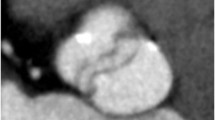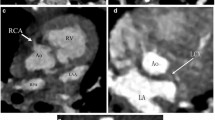Abstract
Purpose
This study was undertaken to define the role of electrocardiographically (ECG)-gated multidetector computed tomography (MDCT) in the assessment of the postoperative ascending aorta.
Materials and methods
From November 2006 to June 2007, 21 patients, [11 men, ten women; age ± standard deviation (SD): 62.7±10.8 years] with a history of ascending aorta replacement underwent ECG-gated MDCT and were prospectively included in our study. Ascending aorta replacement had been performed with different surgical techniques: Bentall-De Bono (four patients, 19%), Tirone-David (five patients, 23%), and modified Tirone-David with creation of aortic neosinuses (12 patients, 57%). Two patients were excluded from MDCT evaluation because they failed to fulfil the inclusion criteria. Transthoracic echocardiography was used as the reference standard. All patients provided informed consent.
Results
In all patients, ECG-gated MDCT provided a clear depiction of the aortic annulus, aortic root and ascending aorta, enabling accurate measurements in all cases. The aortic valve area (3.4±0.2 cm2), the diameter of the sinotubular junction (31.6±1.8 mm), the diameter of the neosinuses in the case of modified Tirone-David procedures (37.3±2.1 mm) and the distance between the cusps and the graft wall during systole (3.1±0.7 mm) fell within standard ranges and showed a good correlation (r=0.89) with the values obtained with transthoracic echocardiography.
Conclusions
MDCT is currently considered a compulsory diagnostic step in patients with suspected or known aortic pathology. MDCT is a reliable technique for anatomical and functional assessment of the postoperative aortic root and provides cardiac surgeons with new and detailed information, enabling them to formulate a prognostic opinion regarding the outcome of the surgical procedure.
Riassunto
Obiettivi
Definire il ruolo della TCMD cardio-sincronizzata nella valutazione dell’aorta ascendente post-chirurgica.
Materiale e metodi
Dal novembre 2006 al giugno 2007 sono stati inclusi prospetticamente nel nostro studio 21 pazienti (11 maschi, 10 femmine; età media 62,7±10,8 anni) non consecutivi sottoposti ad intervento di sostituzione dell’aorta ascendente. I pazienti sono stati sottoposti a sostituzione dell’aorta ascendente mediante intervento di Bentall-De Bono (4 pazienti, 19%), Tirone-David (5 pazienti, 23%) e Tirone-David modificato con ricostruzione dei “neo-seni” (12 pazienti, 57%). Due pazienti sono stati esclusi dalla valutazione mediante TCMD perché non rientravano nei criteri di inclusione. Come tecnica di imaging di riferimento di confronto è stata utilizzata l’ecocardiografia transtoracica. Tutti i pazienti hanno fornito il consenso all’esame.
Risultati
In tutti i pazienti la TCMD cardio-sincronizzata ha permesso una chiara valutazione dell’anulus valvolare, della radice aortica e dell’aorta ascendente per cui è stato possibile effettuare accurate misurazioni. È stato possibile calcolare l’area valvolare (3,4±0,2 cm2), il diametro della giunzione sino-tubulare (31,6±1,8 mm), il diametro dei “neo-seni” nel caso di intervento di Tirone-David modificato (37,3±2,1 mm) e la distanza cuspidi-graft in fase sistolica (3,1±0,7 mm), che si sono dimostrati rientrare nei range di normalità ed avere una buona correlazione (r=0,89) con i valori ottenuti mediante l’ecocardiografia transtoracica.
Conclusioni
La TCMD è considerata un momento diagnostico obbligatorio nei pazienti con sospetta o nota patologia aortica. La TCMD si è dimostrata affidabile nella valutazione anatomica e funzionale della radice aortica e fornisce al cardiochirurgo nuove e dettagliate informazioni per esprimere un giudizio prognostico sull’esito dell’intervento.
Similar content being viewed by others
References/Bibliografia
Takahashi K and Stanford W (2005) Multidetector CT of the thoracic aorta. Int J Cardiovasc Imaging 21:141–153
Fleischmann D (2002) CT angiography (CTA). Wien Med Wochenschr 113:53–58
Sommer T, Fehske W, Holzknecht N et al (1996) Aortic dissection: a comparative study of diagnosis with spiral CT, multiplanar transesophageal echocardiography, and MR imaging. Radiology 199:347–352
Philippe F (2004) Invasive angiography, computed tomography or magnetic resonance imaging for coronary imaging and cardiovascular risk stratification? Regulatory and practical considerations. Ann Cardiol Angeiol (Paris) 53:79–90
Fleischmann D, Rubin GD, Paik DS et al (2000) Stair-step artifacts with single versus multiple detector-row helical CT. Radiology 216:185–196
Kalender W (2000) Computed tomography: fundamentals, system technology, image quality, applications. MCD Verlag, Munich
Kalender WA (1995) Technical foundations of spiral CT. J Belge Radiol 78:68–74
Kalender WA, Prokop M (2001) 3D CT angiography. Crit Rev Diagn Imaging 42:1–28
Kalender WA, Vock P, Polacin A, Soucek M (1990) Spiral-CT: a new technique for volumetric scans. I. Basic principles and methodology. Rontgenpraxis 43:323–330
Kalender WA, Wedding K, Polacin A et al (1994) Basic principles of vascular imaging with spiral CT. Aktuelle Radiol 4:287–297
Novelline RA, Rhea JT, Rao PM, Stuk JL (1999) Helical CT in emergency radiology. Radiology 213:321–339
Cigarroa JE, Isselbacher EM, DeSanctis RW, Eagle KA (1993) Diagnostic imaging in the evaluation of suspected aortic dissection. Old standards and new directions. N Engl J Med 328:35–43
Runza G, La Grutta L, Alaimo V et al (2007) Comprehensive cardiovascular ECG-gated MDCT as a standard diagnostic tool in patients with acute chest pain. Eur J Radiol 64:41–47
Nikolaou K, Saam T, Rist C et al (2007) Pre- and postsurgical diagnostics with dual-source computed tomography in cardiac surgery. Radiologe 47:310–318
Runza G, La Grutta L, Alaimo V et al (2008) Influence of heart rate in the selection of the optimal reconstruction window in routine clinical multislice coronary angiography. Radiol Med 113:644–657
Cademartiri F, Runza G, Belgrano M et al (2005) Introduction to coronary imaging with 64-slice computed tomography. Radiol Med 110:16–41
Kallenbach K, Pethig K, Schwarz M et al (2001) Valve sparing aortic root reconstruction versus composite replacement — perioperative course and early complications. Eur J Cardiothorac Surg 20:77–81
Author information
Authors and Affiliations
Corresponding author
Rights and permissions
About this article
Cite this article
Runza, G., Fattouch, K., Cademartiri, F. et al. ECG-gated multidetector computed tomography for the assessment of the postoperative ascending aorta. Radiol med 114, 705–717 (2009). https://doi.org/10.1007/s11547-009-0402-x
Received:
Accepted:
Published:
Issue Date:
DOI: https://doi.org/10.1007/s11547-009-0402-x




